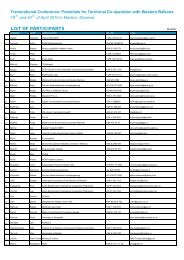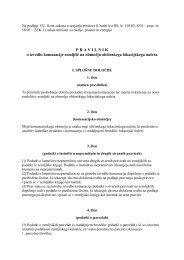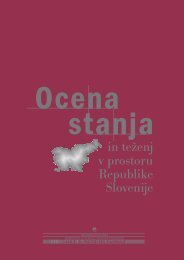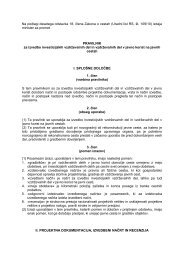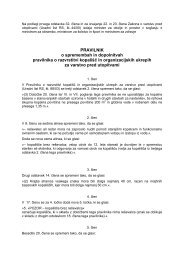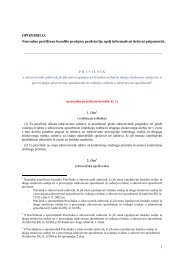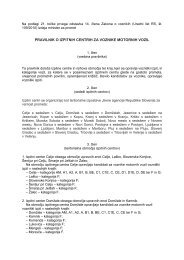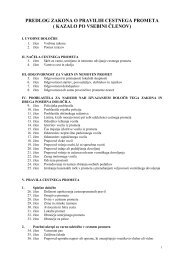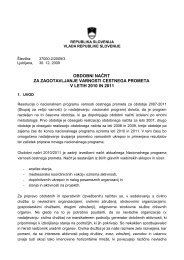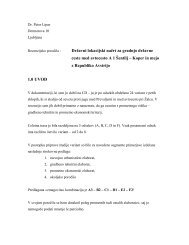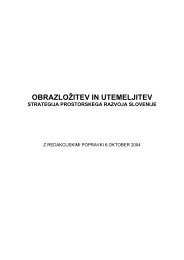evropska konvencija o krajini - Ministrstvo za infrastrukturo in prostor
evropska konvencija o krajini - Ministrstvo za infrastrukturo in prostor
evropska konvencija o krajini - Ministrstvo za infrastrukturo in prostor
Create successful ePaper yourself
Turn your PDF publications into a flip-book with our unique Google optimized e-Paper software.
178Delavnica 2 / Workshop 2podkonzulate. Izgradnja Sul<strong>in</strong>skega svetilnika jebila potrjena 2. novembra 1865 z »Javno list<strong>in</strong>oo donavski navigaciji«. Gradnja po naročiludonavske komisije na podlagi načrtov angleških<strong>in</strong>ženirjev Ch. Hartleya <strong>in</strong> M. Engelhardta je bilakončana leta 1870. Danes je svetilnik zgodov<strong>in</strong>skispomenik. Mesto, ki so ga <strong>za</strong>znamovaleštevilne kulture, ohranja bogato kulturnodedišč<strong>in</strong>o <strong>in</strong> arhitekturne spomenike iz 19.stoletja.Sul<strong>in</strong>a se je sčasoma razvila kot medetničnoobmočje <strong>za</strong>radi priseljevanja <strong>in</strong> nastanitev, ki sopoleg Romunov obsegale še: Grke, Ruse,Lipovane, Turke, Francoze <strong>in</strong> Angleže, ki so živeliskupaj v večkulturnem okolju. Večetnični vidikse odraža ločeno od večverskega. Leta 1904 stao številnih veroizpovedih pričali dve ortodoksnicerkvi (grška cerkev <strong>in</strong> cerkev, ki je pripadalaone available for navigation at that time). Thus,<strong>in</strong> 1745, Aga Besir, the head of the imperialharem, made, at his master’s order, a substantialdonation for the build<strong>in</strong>g of a lighthouse,which was supposed to guide the boats to themuch visited harbor.After 1900, the grow<strong>in</strong>g <strong>in</strong>terest of big Europeancountries for this area situated at the end ofRomania <strong>in</strong>creased the city importance. Austriaand Belgium opened a consulate, and England,Denmark, Netherlands, Greece, Turkey and Russiaopened vice-consulates. The build<strong>in</strong>g ofSul<strong>in</strong>a lighthouse was decided on November 2 nd1865, through »The Public Act of Danube Navigation«.The construction, made for DanubeCommission after the plans of the English eng<strong>in</strong>eersCh. Hartley and M. Engelhardt, was f<strong>in</strong>ished<strong>in</strong> 1870. Nowadays, the lighthouse is a historicalmonument. This city marked by variouscultures, preserves a rich cultural heritage andan architectural reservation dat<strong>in</strong>g from the 19 thcentury.32.Zaradi njenega hitrega razvoja je Pariška pogodba (marec 1856)določila Sul<strong>in</strong>o <strong>za</strong> sedež Evropske komisije <strong>za</strong> Donavo (CED) doleta 1921. Glavni namen komisije je bilo <strong>za</strong>gotoviti prosto plovbopo Donavi, med Isacceo <strong>in</strong> izlivom v Črno morje. Po dveh letih soAvstrija, Francija, Anglija <strong>in</strong> Turčija sklenile <strong>za</strong>menjati komisijo sstalno upravo držav ob reki : Avstrije, Bavarske, Wurtenberga,Turškega cesarstva, pa tudi Moldavije, Valahije <strong>in</strong> Srbije podpogojem sporazuma s Turškim cesarstvom. Kmalu <strong>za</strong> tem se je<strong>za</strong>čelo reguliranje rokava Sul<strong>in</strong>a.Due to its fast development, the provisions of the Paris Treaty(March 1856), made Sul<strong>in</strong>a the place of the European Commissionof the Danube (CED), up to 1921. The ma<strong>in</strong> purpose of theCommission was to assure free navigation of the Danube, betweenIsaccea and the flow <strong>in</strong>to the Black Sea. After two years, Austria,France, England and Turkey decided to replace the Commission bya permanent Board of the riverside countries: Austria, Bavaria,Wurtenberg, Ottoman Empire, but also Moldavia, Vallachia andSerbia, with the condition of the Ottoman Empire agreement.Shortly after, began the regulari<strong>za</strong>tion of the Sul<strong>in</strong>a branch.33. a, bSul<strong>in</strong>a is developed <strong>in</strong> time, as an <strong>in</strong>ter-ethnicalarea, because of the immigration and establishmentof other cultures besides Romanians:Greeks, Russians, Lippovans, Turks, French andEnglish people, who lived together <strong>in</strong> amulticultural system. The multi-ethnical aspectis expressed <strong>in</strong>dependently from the multi-confessionalone. In 1904, practic<strong>in</strong>g various religionswas attested by the 2 orthodox churches(the Greek church and the one belong<strong>in</strong>g to theRomanian community), 3 old rite churches (belong<strong>in</strong>gto the Lippovan community), 1 catholicchurch, 1 protestant church, 1 Anglican church,2 mosques and an Armenian house of prayer. Inthe 1904’s census, the member of Greek <strong>in</strong>habitantsreached 2,056 out of the total of almost10,000. Many came from the island ofKeffalonia, from the Ionic Islands Archipelago.The Greek community represented the biggestshare, compar<strong>in</strong>g to the other cultures: 803Romanians, 444 Armenians, 594 Lippovans,286 Turks, 211 from the Austro-Hungarian Empire,17 Germans, etc. A part of Commission’spermanent employees used to live <strong>in</strong> the city.The Greek orig<strong>in</strong> citizens occupied traditionallywith merchandise and pilot<strong>in</strong>g, tak<strong>in</strong>g high positionsconcern<strong>in</strong>g the command of ships on theSul<strong>in</strong>a branch, and a big part of them were shipowners. The history of the Hellenic communityis refound by the presence of the monumentsrepresent<strong>in</strong>g its evolution, such as the Greek



